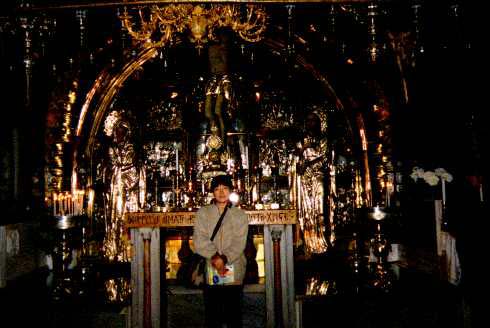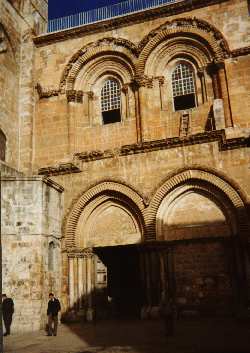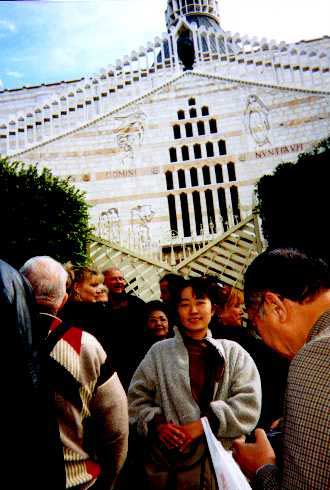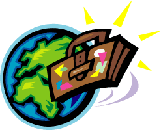Israel: A Land of Diversity
page three
 |
The Church of the Holy Sepulchre, marking the spot (maybe)
where Christ died and was buried.
|
|
The Temple Mount was just one stop on a busy December 24 itinerary
for Mioko and Akiko. They also visited the Mount of Olives, where “Christ
prayed, and his sweat was like blood”; and the Church of the Holy
Sepulchre, believed to have been built on the spot where Jesus’
tomb was. It was originally built in the 4th century, with the Church
of the Crucifixion—on the supposed site of Jesus’ death, a
hill known as Golgotha—next to it; during the Crusades, the two
buildings were joined together.
“I thought Golgotha was a place like a mountain, a small mountain,
but that’s not a mountain anymore,” Mioko points out. “I
think 2000 years ago there was a mountain in that place, but today it’s
inside the Old City.
“I think we were lucky,” she says, in a major understatement,
“but we found a Franciscan Priest from Japan while we were taking
pictures together, and he said, ‘I have some time so if you want
I will explain to you about the history of the church.’ And he
explained that Golgotha was about 6 meters higher than now, because
they dug to take some rocks from there for building, so that’s
much lower than before.
“He said there was a cross inside the church that, they say, Christ
was on, but he said he’s not sure. Inside the church is where he
was on the cross, actually. But [the priest] said they are only symbols.
Maybe not the exact spot, but if Christians come here, they can say
, ‘Well, I saw the tomb of Christ.’
 |
| The Church of the Holy Sepulchre |
“There is a tomb of Christ too—inside the church there is
a tomb. But I’m not sure that inside that there is really Christ.”
Who’s buried in Christ’s tomb? According the Bible, nobody!
“The priest said, ‘Those are only symbols,’” Mioko
responds. According to Kollek and Pearlman’s book, many of these
churches marking important events in Jesus’ life were constructed
by Constantine the Great, the first Roman Emperor to accept Christianity,
after his mother, Queen Helena, visited the Holy Land and “identified”
these sites. There is not complete agreement among modern scholars that
the Church of the Holy Sepulchre stands on the site of Christ’s
death and burial. In fact, there is a second suggested site, the Garden
Tomb, located north of the city.
Mioko and Akiko returned to the Church of the Holy Sepulchre on Sunday,
December 28. The church includes four naves, and a church service was
going on in each one: Russian Orthodox mass in one, Coptic Mass in another,
Armenian Christians in another... “That Franciscan Priest said
there are many types of Christians, ‘but Christ is one so we all
believe in Christ, we believe in the same religion, so we don’t
care much!’”
As a typical Japanese, with little religious background, Mioko found
such a site rather awe-inspiring. “To see so many religious people,
different religious people at the same time is, how to say, impressive.
Because I don’t believe in a special religion, so it made me wonder
why they do this, do mass so many times. Maybe they think they can get
something from that mass.” Noting that her other destination on
this trip, Vienna, also has many churches, she muses, “maybe that’s
a good place to think.”
Stations of the Cross
1. Jesus is condemned.
2. Jesus carries his cross.
3. Jesus falls.
4. Jesus meets his mother.
5. Simon helps Jesus.
6. Veronica helps Jesus.
7. Jesus falls again.
8. Jesus consoles the women.
9. The third fall.
10. Jesus is stripped.
11. Jesus is crucified.
12. Jesus dies.
13. Jesus is taken down.
14. Jesus is buried.
A fifteenth station, “The Resurrection”, is sometimes
added.
|
Leading to this church is the Via Dolorosa, the “painful way”
which Jesus is said to have followed on his way to Golgotha, where he
was nailed to the cross. “Before he was nailed to the cross, he
was whipped, then he walked with the cross on his back, then someone
bore the cross instead of Christ. That was Peter. At some point, a woman
wiped his head with her handkerchief...” Mioko refers to the Stations
of the Cross, a chronology of events that led up to Jesus death. (see
sidebar)
“And on Christmas Eve in the afternoon we went to Bethlehem,”
Mioko continues. “That’s about 15 minutes by bus. And we went
there by bus, but on that day I heard the news that Arafat will visit
there. Arafat is visiting Jerusalem, so the police and army are very
strict, and the bus station was far from Bethlehem, so we had to walk
about ten minutes to the bus station, and then go to the church of Nativity.”
The Church of the Nativity was founded in AD 330. Since Christmas
commemorates the birth of Christ in Bethlehem, the Church of the Nativity
is a rather raucous place on Christmas Eve. “There was a festival
here,” Mioko recalls, “and there were many people, and a TV
camera also.
“I met a Palestinian girl, student, who speaks English, there.
And she was very kind and she showed us to the church of Nativity.”
Mioko recalls that the girl told her, “Bethlehem is on the West
Bank. She said if you go inside here it’s not Israel, it’s
the West Bank.” The girl was Islamic, so it surprised Mioko that
she would attend a Christmas ceremony at the Church of the Nativity.
“But that Palestinian girl said the Christian ceremony is very
beautiful, so she visits the Nativity Church to see the ceremony.”
On Christmas Day they visited the Dead Sea and the Masada fortress.
Masada is accessed by cable car. It’s a famous site because it
was captured by Jews during their first century revolt against Rome,
and it also became the site of a Jewish mass-suicide when they found
that they had no hope of winning the war. “I read that the Israel
soldiers say ‘no more Masada’ because they don’t want
to be destroyed again,” says Mioko. “Up the mountain, I hear
hundreds of people could live in here, there were many buildings and
they could store grain to use a long time.”
The Dead Sea is near Masada. Like the Great Salt Lake in the US, the
Dead Sea has such a high salt content that people can float on the water
with only a very small part of their body being submerged. “I heard
that some people once were floating and went to the other side, to Jordan,
but they didn’t have a visa for Jordan. So there was a problem!”
Maybe they could float back to Israel?
Flipping through her photos, Mioko displays two showing people making
faces for the camera. “There are some mysterious photos,”
she says. While at the Dead Sea, she left her camera unattended for
about 15 minutes; when she had her photos developed later, she found
that these two photos had been taken during that time. “They are
crazy people!” she laughs.
There is a resort with hot springs near the Dead Sea—but not as
near as it used to be. From the resort, Mioko says, “you have to
walk about one kilometer to the shore of the Dead Sea, because the Dead
Sea is shrinking, and the shore became far from the resort. There is
a car from here to the shore, so if you wait you can take a car.”
The Dead Sea is also well known for its mud, which is said to be good
for skin. “I tried this mud but there are many people trying this.
I saw a very old woman, like 80 years old.”
The next day, our two travelers visited a large market in the New City.
“The prices there were expensive like Japan,” she recalls.
“If I take a bus, 180 yen, about, so that’s the same as Japan.
But the fruits and vegetables in the market are very cheap, so I bought
oranges.” On this same day, they visited the Israel Museum and
saw the Dead Sea Scrolls, which are housed in a special building there
called the Shrine of the Book.
December 27’s destination was the Sea of Galilee, where Christ
is said to have walked on the water. “I can’t walk on the
water, so we took a boat,” says Mioko. “The wind was very
strong. I met a Philippine girl and she said she was afraid because
the wind was too strong, but she said she is evangelical. So I said,
‘But Christ walked on the water!’” Near the Sea of Galilee,
is where the Bible says Christ performed his miracle with the loaves
and fishes. Naturally, a church has been built on the purported site
of this miracle!
 |
| The Church of the Annunciation, Nazareth. This church commemorates
the Angel Gabriel’s announcement to Mary that she would give
birth to Jesus. |
Also that day they visited the Church of Annunciation, in Jesus’
boyhood home of Nazareth. “In the church there are many wall pictures
from all over the world,” Mioko says, finding a particular photo,
“and this picture was drawn by a Japanese, so Mary looks Japanese,
Christ like Taro,” the Japanese folk story character!
Before leaving Israel on December 28, they visited Golgotha (as mentioned
above), then walked on the wall of the Old City. “Tourists can
walk around on top of the wall,” she says. “It takes about
one hour or two hours to walk all the way around the Old City on the
wall.” There are four gates for entering the Old City—Jaffa,
Lion, Golden, and Damascus— , but I noticed in her photos
that one gate was blocked. This, she explained, was the Golden Gate.
“The Golden Gate was closed by the Muslims because there was a
Jewish legend that someday, at the end of the world a Messiah will come
through the Golden Gate. So the Muslims closed that door.” Actually,
Kollek and Pearlman say that this is a Muslim belief, and that it was
more likely that the closing of the gate, through which tradition says
Christ entered Jerusalem, was done for security reasons.
After a week of seeing the historic sites of Israel, Mioko and Akiko
were faced with the reality of modern Israel that we all know from the
evening news. “To go out from Israel, we have to have an interview
with the security guard,” Mioko says. “They are polite, but
they ask me many questions. ‘Did you go to West Bank? Do you have
a friend here? Who packed your luggage?’ About 15 minutes per person.”
Because of this interview, she says, they needed to reach the airport
about three hours before the flight; airlines will not wait for you
if you are delayed by the security interview.
“They are afraid of the bomb, so they asked many questions about
explosives,” she laughs. “’Do you have explosives?’
‘No!’ But if I had a bomb I probably wouldn’t want to
tell them!”
Additional sources:
Jerusalem by Teddy Kollek and Moshe Pearlman. 1968;
Random House, New York.
Introducing the Holy Land by Max Miller.1982; Mercer
University Press.
“Who’s to blame for the Jerusalem clash?” Time,
October 22, 1990
Links
The Jerusalem
Web site
InIsrael.com
-- for planning a trip to Israel
History
of Israel and Palestine with lots of maps
Israel
and the Palestinian Territories -- from the Lonely Planet Worldguide
From Israel, Mioko and Akiko went to Austria; we’ll present
Mioko’s description of that part of the trip on Travel & Culture
in the near future.
Travel
& Culture Home




 This page last updated
December 9, 2002
. E-mail Tim
This page last updated
December 9, 2002
. E-mail Tim